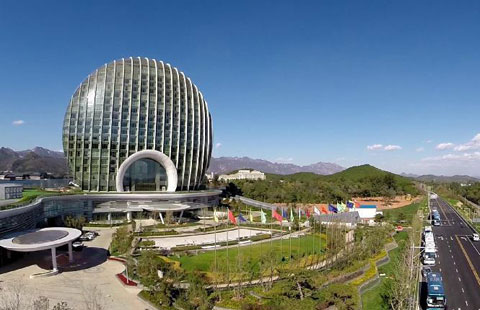
APEC venue: Sunrise East Kempinski Hotel in Beijing (chinadaily.com.cn)
While Chinese President Xi Jinping is busy greeting world leaders this week at the Asia Pacific Economic Cooperation (APEC) summit in Beijing, here in the quiet, old Dutch town of Galle, Sri Lanka, Chinese tourists are visiting one of the best preserved colonial-era cities in Southeast Asia. Indeed, Sri Lanka is popular among Chinese tourists and the Chinese are popular among Sri Lankans for the investment and tourist rupees they bring. The Sri Lankan and Chinese governments are currently experiencing a time of booming economic relations and warming relations, as China has invested heavily in Sri Lanka in recent years, funding airports, roads, railways and ports. A proposed Free Trade Agreement (FTA) between the two nations is scheduled to be signed in June 2015, and over the last two months, Sri Lankan authorities have even allowed the docking of a Chinese submarine and warship at its port in Colombo – angering the Indian government. Indian authorities are also concerned over plans by China to build an aircraft maintenance facility in the eastern port city of Trincomalee, a strategic location in terms of national security.
During a state visit in September, Chinese President Xi Jinping secured a verbal commitments from Sri Lanka, as well as Tajikistan and the Maldives for a “New Silk Road Economic Belt” first mentioned during his speech in Astana, the capital of Kazakhstan on Sept. 7, 2013. India and Afghanistan have also show interest. The plan is widely touted as representing a significant shift in China’s strategy, moving away from a purely domestic focus toward an outflow of Chinese investment in its neighbors.
Xi’s “New Silk Road Economic Belt” envisions combining the ancient land-based road with a maritime route, to help boost economic cooperation among the neighboring countries. Xi has identified his home province of Shaanxi as the starting point for the old Silk Road, although according to a map published in May on the official Xinhua News Agency website, the land-based Silk Road starts from the ancient capital city of Xi’an, stretching west through Urumqi and running southwest across Central Asia, the Middle East and Europe. The Maritime Silk Road starts in the southern Chinese province of Guangdong, and runs through the Chinese island of Hainan, then through the Malacca Strait and Indian Ocean before entering the Red Sea and Mediterranean. The two roads are supposed to meet in Venice.
To move forward with his plan to economically integrate the countries along the centuries-old Silk Road, Xi has announced a $40 billion infrastructure fund to finance the construction of infrastructure facilities such as railways, roads and pipelines and overseen by such Chinese policy banks as the China Development Bank.
Yet all may not go exactly in China’s favor, as witnessed by this week’s announcement in Vietnam that Thailand has surpassed China to become the largest exporter of vegetables and fruits into Vietnam. Vietnamese official statistics revealed show that imports of vegetables and fruits (mainly durian, mangosteen and tamarind) from Thailand were valued at greater than $135 million (34.2 percent of Vietnam’s market share), compared with nearly $100 million (23.1 percent) from China at the end of September.
While some analysts believe the loss in market share of Chinese products is due in part to a Vietnamese customers’ boycott of Chinese goods following the deployment of an offshore oil drilling rig in May, Vietnamese customers are also very wary of the quality of Chinese fruit and vegetables. Many Vietnamese have long complained of poor produce quality coming from China and are refuse to buy Chinese produce.
So while Xi Jinping’s grand strategy to facilitate trade among neighboring countries by building infrastructure is quite laudable in theory, in practice the success of his scheme may be held hostage by geopolitical concerns and quality problems. The above example in Vietnam of a refusal to buy Chinese fruits and vegetables may be small peanuts in terms of the total amount of trade conducted among China and its neighboring nations, but until Beijing addresses the long-standing quality problems of its exports the benefits of an increase in infrastructure may go disproportionately to its neighbors selling into China.